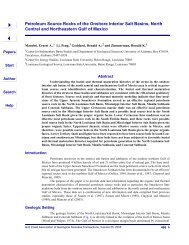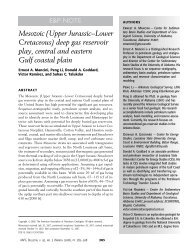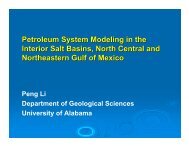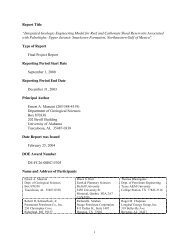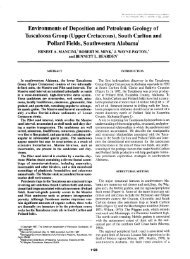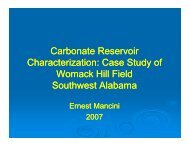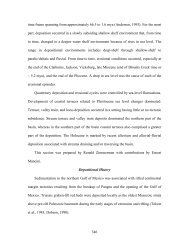Norphlet Formation (Upper Jurassic) - Berg - Hughes Center
Norphlet Formation (Upper Jurassic) - Berg - Hughes Center
Norphlet Formation (Upper Jurassic) - Berg - Hughes Center
Create successful ePaper yourself
Turn your PDF publications into a flip-book with our unique Google optimized e-Paper software.
Ernest A. Mancini et al 891^ ^EXPLANATIONSource AreaAlluvial Fan'•^-^ Alluvial Plainn ^Wadi- Desert Plain/I DuneUpdip Limit of the<strong>Norphlet</strong> <strong>Formation</strong>Figure 11—Generalized <strong>Norphlet</strong> paleogeography for southwesternand offshore Alabama.ments are interbedded with moderately well-sorted towell-sorted sandstones having low to high-angle bimodalforeset laminae (Figures 5C, 6A). These texturally maturecross-bedded sandstones are probably eolian in origin.Deposition in this area of southwestern Alabama,although dominated by fluvial processes (Figure 12), wascharacterized by having a combination of fluvial andeolian sediments similar to the mode of accumulation forthe Permian sediments of Scotland as described by Clemmensenand Abrahamsen (1983).In modern-day deserts, wind-laid sands are commonlyinterbedded with water-deposited sediments of a wadi(Glennie, 1970; Reineck and Singh, 1975). The wadis typicallyoccur adjacent to highlands and are characterized bysporadic and abrupt fluvial activity and by a low water tosediment ratio resulting in relatively poor sorting. Wadiflow pattern is similar to a braided stream, and the verticalchange in grain size and flow regime decreases upwardanalogous to a fluvial system (Glennie, 1970; Reineck andSingh, 1975). During dry periods, wadi channels canbecome filled with eolian sand.The Denkman Sandstone Member, which is principallya quartz-rich lithofacies of the <strong>Norphlet</strong>, accumulated asdesert plain sediments in dune, interdune, wadi, and playalake deposits. The <strong>Norphlet</strong> in southwestern Alabama hasbeen interpreted as eolian by Wilkerson (1981), Hondaand McBride (1981), and Pepper (1982). The <strong>Norphlet</strong>desert plain of southwestern Alabama was rather broad,extending westward into eastern and central Mississippiwhere the upper <strong>Norphlet</strong> has been determined as eolianby Hartman (1968), Badon (1975), and McBride (1981).The desert plain was bordered on the north and east by theAppalachians and to the south by a developing shallow sea(Figures 11, 12). The principal source of the sand was theupdip alluvial fan and plain and wadi deposits. Also, awadi system probably was associated with the Wigginsarch as evidenced by the <strong>Norphlet</strong> being characterized byhaving granule-size clasts in northern Mobile County Forthe most part, the sand was transported by the wind intothe desert plain area. Water-deposited sediments accumulatedin wadis and playa lakes in interdune areas. Depositionin this area of Alabama was dominated by eolianprocesses (Figure 12). Dunes were better developed than inthe previously described updip areas. In fact, this area wasprobably the region of maximum dune development.The most distinguishing features of the Denkman arethick sets of moderately well-sorted to well-sorted, highangle(up to 30°), bimodal foreset laminae (Figure 5B) andseveral types of penecontemporaneous, soft-sedimentdeformation structures, including contorted bedding (FigurelOB) and small-scale faults (Figure lOE). The dune andinterdune environments of the Denkman are dominatedby quartz-rich sandstones that are texturally mature, beingwell-sorted and having rounded quartz grains (Figure 4B),and that have a composition of a significant percentage offeldspar (Figure 4A). The presence of a significant percentageof feldspar in the Denkman is attributed to theproximity and nature of the eroding source terrain and tothe arid climate during <strong>Norphlet</strong> deposition.These sedimentary characteristics of the Denkman indicateit accumulated in an eolian environment. Moderndesert dune sediments are typified by thick deposits ofrather uniform lithology containing planar cross-bedshaving low to high-angle, well-sorted individual foresetlaminae (McKee, 1966, 1979a; Glennie, 1970, 1972Bigarella, 1972; Wilson, 1972; Reineck and Singh, 1975Hunter, 1977, 1981; Walker and Middleton, 1979Kocurek and Dott, 1981; Ahlbrandt and Fryberger, 1982).Soft-sediment features—such as slump features, contortedbedding, and small-scale faults—are common inmodern dune sands (Glennie, 1970; Bigarella, 1972,1979;Reineck and Singh, 1975; McKee, 1979a; Kocurek andDott, 1981; Ahlbrandt and Fryberger, 1982).The <strong>Norphlet</strong> high-angle cross-bedded sandstones areprobably dune deposits (Figure 5B, C), which accumulatedas a result of oversteepening of a dune lee slope andsubsequent avalanching down a slipface (sandflow orgrainflow), whereas the horizontally to low-angle laminatedsandstones (Figure 5E, F) accumulated as a result offlow separation on the lee side of the dune (grainfall).Modern sand dunes are typically composed of two typesof deposits, including accretion deposits characterized by




